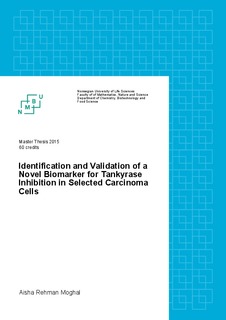| dc.description.abstract | Tankyrase is a key regulator of cell signaling and metabolism [1]. Tankyrase is a catalytic
enzyme that modifies protein turn-over through a post translational modification called
poly(ADP)-ribosylation [1]. One of the central target proteins of tankyrase mediated
poly(ADP)-ribosylation is AXIN1/2 that regulate the canonical WNT/β-catenin pathway
[1][2][3]. Tankyrase inhibition leads to reduced cell growth accompanied with reduced levels
of β-catenin, the key mediator of the canonical WNT/β-catenin pathway, in selected cancer
cell lines [3][4]. However, in several other cancer cell lines, growth reduction by tankyrase
inhibition appears to be independent of altered canonical WNT/β-catenin pathway activity [4].
With the aim of identifying a more general biomarker for tankyrase inhibition, 660 tumor cell
lines were screened for sensitivity to the novel tankyrase inhibitor G007-LK. Among the
cancer cell lines that exhibited growth alteration in response to G007-LK treatment, five cell
lines were selected for further analysis: ABC-1, a non-small-cell lung cancer cell line;
OVCAR-4, an ovarian cancer cell line; A-498, a renal cancer cell line; COLO320DM and
SW480, both colon cancer cell lines.
An expression profile analysis revealed B-cell lymphoma 2 modifying factor (BMF) to be
strongly upregulated in the highly G007-LK sensitive cell line ABC-1. This upregulation was
not accompanied with altered AXIN2 mRNA expression, a hallmark of canonical WNT
signaling [5]. We found that BMF transcription, was upregulated in ABC-1, COLO320DM,
OVCAR-4 and SW480 cells at 24 and 72 hours after exposure to 1 μM of the tankyrase
inhibitor G007-LK (Fig. 3-2A). In A498 cells, an upregulation of BMF transcripts was only
observed at 24 hours (Fig. 3-2A). The upregulation of BMF was accompanied with a downregulation
of AXIN2 transcription in COLO320DM, OVCAR-4 and SW480 cells (Fig. 3-2A).
All selected cancer cell lines show AXIN1 protein stabilization upon tankyrase inhibition at
72 h of G007-LK treatment, while only SW480 and COLO320DM also show a clear downregulation
of β-catenin (Fig. 3-2B, 3-4B).
AMPK-activation has been implicated in the activation of BMF transcription [6] and
upregulated phosphorylated-AMPKα (Thr172) protein levels display AMPK activation [7].
We were not able to detect alterations in phosphorylated-AMPKα (Thr172) protein levels in
G007-LK treated ABC-1 cells (Fig. 3-3B). Also in COLO320DM cells, total APMK protein
levels were unaltered by tankyrase inhibition, but phosphorylated AMPKα (Thr172) protein
levels were substantially raised upon 72 h of G007-LK exposure (Fig. 3-4B, right). In
contrast, total AMPKα levels were reduced by tankyrase inhibition in BMF depleted
COLO320DM cells, compared to cells treated with BMF esiRNA. However, increased
phosphorylated AMPKα (Thr172) protein levels were still seen. In conclusion, tankyrase
inhibition affected AMPK protein levels only in the absence of BMF, again compared to
cells treated with BMF esiRNA. However, G007-LK increased phosphorylated AMPKα
(Thr172) protein levels independent of BMF (Fig. 3-4B, right). To sum up: (i) We established BMF transcripts as potentially broader biomarkers for
tankyrase inhibition in cancer cells compared to the previously used β-catenin biomarker (Fig.
3-2A, 3-2B), (ii) we show a regulatory interaction between BMF and AMPK in
COLO320DM that depends on tankyrase inhibitor G007-LK activity (Fig. 3-4B, right) and
(iii) we finally demonstrate that AMPK phosphorylation (at Thr172) is increased by G007-
LK-mediated TNKS1/2 inhibition, perhaps through AXIN1 stabilization, in COLO320DM
(Fig. 3-4B, right). | nb_NO |
